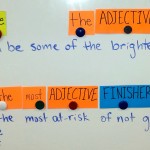In December, Emmanuel, a hypothetical yet typical student from Honduras, moves to the U.S. with his father. Emmanuel, based on his age and previous schooling, is placed into seventh grade. He speaks very little English; more accurately, he can read things like advertisements, and understand a few basic words when spoken to. He knows the numbers and colors. They studied some English at his school back home.
Emmanuel has six classes per day. He is placed into English reading, English writing, English speaking and listening and English grammar, math and computer essentials. There is no room in his schedule for science, social studies or a music class. Emmanuel plays trumpet, and was hoping to be in the band at school, but that will have to wait.
Emmanuel makes quick progress. Within a few weeks, he is confident enough to ask his teachers if he can use the restroom or borrow a pencil, and he can understand a little of what his math teacher is saying. Computer class can be difficult, but he learns by doing, and he likes learning to type.
In February, Emmanuel has to take the AZELLA test. Unsurprisingly, his scores are low. It’s another year in four periods of ELD. He works hard in 8th grade, and his first year of high school, he makes it to intermediate level and only needs two periods of ELD. He finally gets an elective. Should he take his required year of P.E., or should he take band? No matter what his choice, he has a gap to close in science and social studies, now that he can understand at least some of the work.
This is the model of English language acquisition in Arizona. The model has some benefits for a new immigrant, such as giving the student intensive language instruction right away, but overall it can be clunky and often, especially at the elementary level, leads to a segregated environment that can last for years and can perpetuate conceptual gaps created during the years before the student is able to use English to learn. Dual-language programs do exist in Arizona, but they are few.
The rigidity of the current system is the result of a series of court decisions in Flores v. Arizona, and the policies that were developed in response. Even teachers who love teaching ELL’s often chafe against this model, yearning for more flexibility to integrate reading, writing, listening and speaking, or to introduce more content from other subjects (see here and here for some of colleague John Spencer’s thoughts from years past).
I started teaching English Language Development in an audit year, and “compliance” required redesigning our entire schedule one quarter into the year, and creating weeks and weeks of detailed lesson plans from a set of standards that literally takes an entire binder to house in printed form. It was intense.
Next year, our principal wants to do something radical in our traditional junior high school. She is creating five teams of teachers and students, and getting rid of the bell schedule. Each team will be allowed, within a general structure, to develop the use of time and space that best meets their students’ needs. We will also be moving toward competency-based grading and personalization of learning. Technology, collaboration, and flexibility will feature largely.
So much possibility! Wow.
But the legally required 4-hour block of English Language Development classes must meet daily. Even the two required hours for intermediate students imposes an awkward and complex rigidity onto what needs to be a flexible schedule. How will these students be included in flexible teams? If they aren’t, who will their math and science teachers be if all those teachers are working in other teams?
So many questions have clouded my thoughts these past few weeks.
And then… this week… the haze evaporates and into my reverie plops HB2435 (current draft as of 2/18). This bill, if passed, will eliminate the infamous 4-Hour ELD block and allow districts to develop their own research-based language acquisition programs. In the current draft, the hourly requirements would be more flexible, for one:
- Grades K-6: 120 minutes per day, 600 minutes per week, OR 360 hours per year.
- Grades 7-12: 100 minutes per day, 500 minutes per week, OR 300 hours per year.
The word “or” means everything. This means that a school with an alternative bell schedule could flexibly provide the hours required.











Comments 5
I think lawmakers at our state capitol are doing a better job this year at listening. I really enjoyed learning about this. I really appreciated the links so I could learn more. You know in Europe we never had to deal with any of this stuff. If a kid didn’t speak English they put him in the American school and in about a year he or she could understand and in a few years they were fluent. You just had to jump in… The only reason I learned French ( not great just for the record) was because I had no choice but to adapt.. Its when I made English speaking friends that I went back to my unilingual ways..
I think a lot of people relate to that immersion experience. And the kids do need to learn fast! I keep thinking about all the language and culture that get lost along the way. I have students who can’t really say they are literate in English OR their home language, especially when that language is Spanish, because the cultural context in which they are learning both is so complicated, and there is little to no value given to true literacy in Spanish in elementary schools. They are left with whatever they speak at home, but no value is placed on reading/writing Spanish. Then you look at all the job openings that value bilingualism… and there is a disconnect. Not sure what is the ideal program yet.
Woah. I have so much to say about this blog. First, you’re absolutely right about the language acquisition plateau when students are not otherwise inquisitively challenged. Second, your principal sounds like a rockstar; please, please, please write a follow up blog next year about how this idea actualized. Third, I really need to look into this new bill. I can see potential for negative and positive fallout.
There are definitely risks to taking that rigidity away… but there are SO many problems with the current system. Something needs to change, big time. I think as long as there is accountability and it complies with the court decisions, there is a ton of potential.
Thank you for providing an honest insight into the education of an ELL student. It’s so heart-breaking that they are forced to give up content areas and band. I’ve been the Language Acquisition Mentor at my school, and working firsthand with the district and state on student ILLPs was a frustrating process. Our state needs more understanding of how to successfully meet the needs of the ELL students.